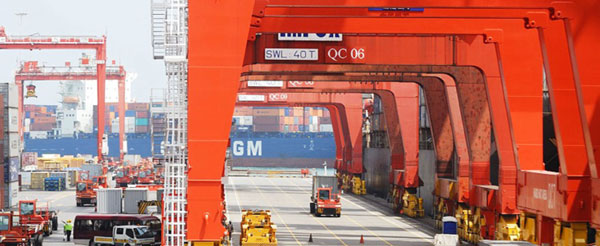02 Dec 2016 - {{hitsCtrl.values.hits}}

In Sri Lanka’s history, successful public-private partnerships (PPPs) are few and far apart. However, one successful project that has demonstrated the ability for a PPP to develop and reform an underperforming asset would be the expansion of the Queen Elizabeth Quay (QEQ) terminal through the South Asia Gateway Terminals (SAGT) partnership.
During the mid-1990s the Colombo Port’s two terminals, the Jaya Container Terminal (JCT) and QUE terminal witnessed a decline in the amount of capacity handled due to inefficiencies and delays caused by outdated systems and equipment. Therefore, in the interest of remaining a globally competitive port, the Government of Sri Lanka prompted the creation of a PPP and thus the SAGT was established.
The SAGT comprised of eight partners, the Sri Lanka Ports Authority, a Sri Lankan investment group, two port management companies, three lending institutions and a shipping company, which were tasked with expanding, operating and managing the QEQ terminal through a 30-year build-operate-transfer (BOT) concession. The key objectives of the project were to expand the QEQ terminal, improve the port’s efficiency and demonstrate to the international community and the private sector the positive outcomes of public-private infrastructure projects.
The construction of the QEQ was completed in August 2003 and the throughput of the QEQ increased by 350 percent over four years. The management techniques used by the SAGT partnership were also emulated for the operation of the JCT and this in turn led to the development and improvement in economic efficiency of the port as a whole, with throughput handled by the entire Colombo port subsequently increasing by 30 percent during the same period.
Right implementation environment
One of the key factors that enabled the success of the SAGT was supportive implementation environment at the time of operation. The establishment of the Bureau of Infrastructure Investment by the Board of Investment (BOI) was a key step towards promoting and facilitating private sector investment in infrastructure. Furthermore, in 2006, the Cabinet Subcommittee on Investment Promotion established a PPP Unit within the BOI, which facilitated projects and generated procurement guidelines. This in turn instilled confidence in the private sector and paved the way for correct project evaluation.
Contract provisions enabled
operational efficiencies
The SAGT project was the first PPP and BOT contract within the Sri Lankan transportation sector. Under the BOT contract, the SAGT partnership was required to offer employment to all existing 500 workers of the QEQ terminal. This provision was included to protect the workers. Furthermore, the contract also required the partnership to source local companies in order to maintain the port facilities. As a result of these provisions, the drivers, janitorial staff and security personnel were not employees of the SAGT and were sourced from local companies.
The expansion of the QEQ through the SAGT partnership, modernized the terminal both physically and in terms of efficiency. The improvements subsequently led to the increase in container capacity to 1.1 million 20-foot equivalent units (TEUs) per year. The number of employees of the SAGT remained at 500 despite the increase in the volume of TEUs handled. This improvement in efficiency can be accounted to the increase in the capacity of the quay and most importantly equipment modernization and better training and work processes.
One of the important underlying reasons for the transformation was the management strategies employed and the transference of technology from the private sector port management companies, which were used by the SAGT partnership. As a result, the company raised its service standards and became the benchmark for ports throughout the country. There was a considerable improvement in efficiency within four years of operation: the handling of TEUs increased 350 percent from 200,186 in 2000 to 899,720 in 2004. Furthermore, there was also a considerable reduction in the average waiting times of vessels, from 6.9 hours in 1997 to 0.9 hours in 2003.
Presently, the Port of Colombo is recognized as one of the leading ports in the world and is ranked among the top 35 ports globally by the World Shipping Council.
(This article is part of the ‘PPP Knowledge Week’ by the Ceylon Chamber of Commerce)
25 Nov 2024 2 hours ago
25 Nov 2024 3 hours ago
25 Nov 2024 3 hours ago
25 Nov 2024 4 hours ago
25 Nov 2024 5 hours ago